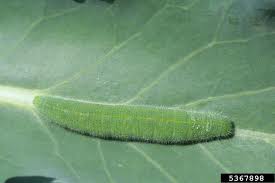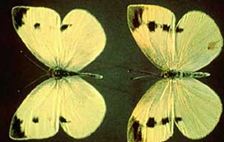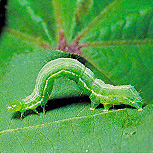Most of this was written by my daughter, Amy Manning
The imported cabbageworm: Have you ever noticed that gorgeous white butterfly that flits around your garden right around the time that the weather starts warming up? Yeah, that beautiful creature is actually laying their eggs on your plants. The eggs will then hatch and then happily munch away on your crops.

This cabbageworm is perfectly camouflaged because it is colored by the leaf it is eating!
This butterfly actually attacks all plants in the brassica family: kale, cabbage, broccoli, cauliflower, kohlrabi, mustards, etc.
When I was a beginning gardener and first encountered these pests, I thought that I was dealing with slugs, as slugs are the bane of us Pacific Northwest gardeners. However, when I went into the information desk at my local nursery, I was told to look very closely at my plants and look for perfectly camouflaged worms and their nearly microscopic eggs. Well, I found them alright. In HUGE numbers.
The eggs are laid on the underside of the leaves. They are cream colored and are so small that you can barely see them. The worms usually feed on the underside of the leaf as well.
Cabbage “looper”: Cabbage loopers are very similar to the
imported cabbageworm. They both attack brassica plants.
The arch in this critters back is why it’s called a “looper”.
Control: The first method of control that works ok with these pests is simple handpicking. Wipe the eggs off, feed the worms to your chickens or destroy them some other way.
Some gardeners recommend going around and trying to catch the butterflies with a butterfly net. But I find this far too laborious, and it does nothing to protect your plants that are currently being attacked.
Eventually though, hand-picking gets to be too much work, especially if you are trying to grow much food for your family.
The only non-toxic (non-toxic to us, anyway) way that I know of that works is by spraying your plants with BT. Bacillus Thuringiesis (BT) is a bacteria and therefore considered a biological pesticide. Since it is relatively specific in attacking caterpillars and not a wide-spectrum bug spray like many conventional products, it is considered organic.
There is a small potential for overuse, which can affect toher types of butterflies and moths. However, from what I can tell, this largely affects mono-culture farms where widespread spraying is applied. So if you do spray BT, make sur eto only spray plants that will become widely affected, and definitely don’t spray any flowers that a beneficial creature might be attracted to.
When you spray, make sure you coat the underside of the leaves, as this is where the majority of the feeding happens
The most important note about using BT: the bottle does not say this (or at least mine does not) you must use a water softener in order for this spray to stick to the plants. All brassica plants have waxy leaves that make water bead up and fall right off. Use a dollop of liquid dishwashing soap in your spray bottle. If you don’t, the BT is not likely to work.
Another highly effective control is with the use of lightweight floating row covers. These exclude the butterflies from your plants.
Here is a link to a bt product at Amazon that has received very good reviews, and is well-priced. It says that it is organic, and also kills caterpillars, gypsy moth larvae, worms, tomato hornworms and cabbage loopers


